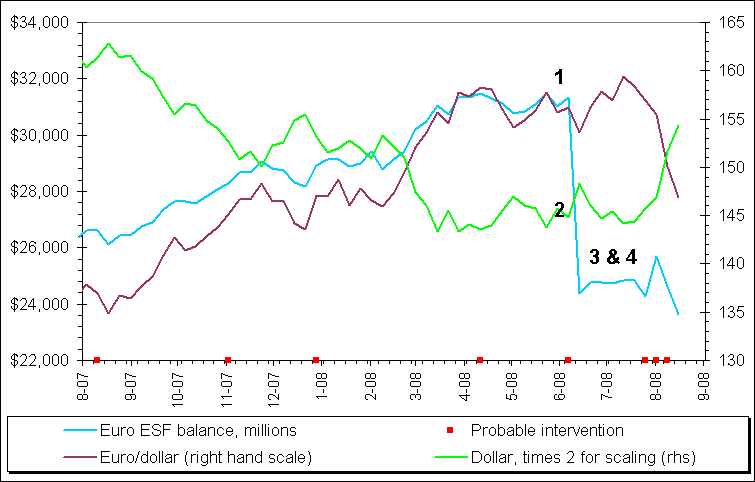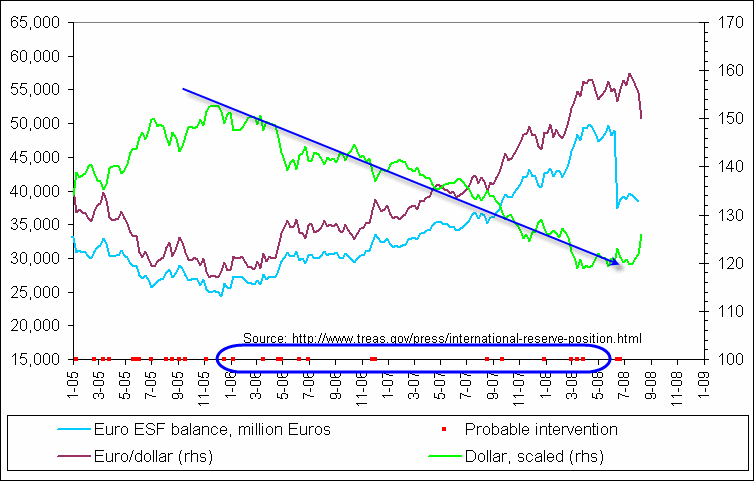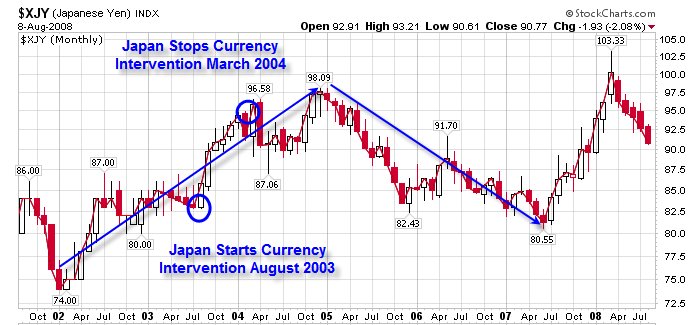Dollar intervention details, dubious journalism
So very few people are aware of the ESF - the Exchange Stabilization Fund of the U.S. Treasury. Every major central bank or country has a similar facility. The ESF was started in 1934 partially as a response to perceived prior dollar manipulation by the Bank of England and others earlier in the decade.
The ESF home page contains this relatively simple explanation of what they can do and what their purpose is:
The legal basis of the ESF is the Gold Reserve Act of 1934. As amended in the late 1970s, the Act provides in part that "the Department of the Treasury has a stabilization fund …Consistent with the obligations of the Government in the International Monetary Fund (IMF) on orderly exchange arrangements and an orderly system of exchange rates, the Secretary ..., with the approval of the President, may deal in gold, foreign exchange, and other instruments of credit and securities."
In simpler terms, the ESF can not only deal in foreign currencies, but also in gold and "other instruments of credit and securities", totally legally. The ESF can serve a valid purpose in helping to stabilize the value of the dollar too - it's not my purpose here to discuss whether its right or wrong.
So, what about the nitty gritty details on the recent dollar intervention? Officially, all we really know is that the now approximately $7 billion dollars has been placed (per the most recent press release at the U.S. International Reserve Position page) and directed into something called "other (foreign currency assets invested through reverse repurchase agreements)" which is a very fancy way of saying that its a loan. For those who want more detail, a fuller definition is here.
That does tell us that it's probably in Euro based repos, but since the classifications are not terribly specific and we do know that governments have been known to not always be fully open and above board about what they're doing, we really don't know for sure what it is.
A close up of the period from Sept 2007 through early August 2008:

The actual timing and dollar details of the recent intervention are as follows:
- As of the reporting weeks ending June 13th & June 20th, $6.381 billion dollars were sold by the ESF in Euros (Euros were sold, dollars were bought). The ESF maintains the account balances in dollars, but the money is actually in Euros (or Yen for the Yen portion).
- During that first week, the value of the dollar index moved from 72.39 to 74.15 and then back to 73.43 the following week.
- The reporting of the ESF actions from the weeks ending June 13th & June 20th was not made public until July 14th.
- The dollar index closed at 71.87 on July 15th, which was the recent low.
The actual facts show that the ESF intervention preceded *any* other significant factor to the dollar move.
Regarding the many previous red dots on the chart that show probable intervention prior to June 2008, just the almost perfect match between the Euro ESF balance and the Euro value lines should tell the story of how well the various small operations worked. Even more, the two lines converge quite well between September 2007 and May 2008 and are strong evidence of the very probable small ESF interventions. Note also that the algorithm to determine probable intervention is proprietary... and feel free to ignore or disbelieve it in spite of the evidence of the closing gap. Also note that currency intervention can be done in both directions. And also note this quote, which is key in understanding interventions in general:
...dollar holdings of foreign governments and central banks rose by $41 billion in 1986 and kept rising this year; that represents their intervention in currency markets. Hence, at the exchange rates that prevailed last year, private capital inflows to the United States were not enough to finance its current-account deficit. "Without official intervention," Mr. Perry said, "the dollar would have fallen even further than it has." -- New York Times, 1987
As an aside, one of the oddest items about the ESF is that the best we can tell, about 70% of its initial funding in 1934 came from proceeds of F.D.R.'s confiscation of gold and its subsequent revaluation from $20 to $35/oz.
The following is commentary on dubious blogging / journalism, specifically in the dollar intervention area and regarding Mike "Mish" Shedlock and his recent blog about intervention and my work as posted on iTulip. Skip it if you're uninterested.
First, a definition: Dubious Journalism: Journalism that exploits, distorts, or exaggerates the news to create sensations and attract readers.
This is the chart he posted. He added both the dark blue trend line and the dark blue oval.

His first comment was "Assuming one buys the story, what stands out is 13 consecutive alleged interventions that all failed.".
- "Assuming one buys the story" and also using the word "alleged" shows a massive disregard of the actual facts of what the ESF did and what the facts and effects were and are. Translation - spin.
- It also shows an attempted distortion of what actually happened, as noted in points 1-4 above.
- The trend line he drew shows that he did not read and fully understand, intentionally or not, my original statement "...recent data about the drop was delayed for almost three weeks before it was made public" per points 3 & 4 above. Yet another distortion or at least shoddy work and very poor assumptions on his part - at best.
- To characterize the most recent intervention as a "failure", and without noting any time period, when the actual evidence shows an almost perfect match between the bottom on July 15th and the ESF public announcement (as well as an actual huge subsequent move in the dollar index) is mind boggling and sensationalist at best.
- Refer to the above quote from the NY Times regarding intervention and its many possible purposes, as well as the actual evidence of the closing gap between the ESF Euro balance and the Euro value, and again we have a major issue with the "all failed" assertion... and more sensationalism and distortion of the actual facts. To actually fail to believe that the resources of a country and a central bank can not affect that's country's currency value is almost ludicrous in my opinion.
- Later on, Mish notes "failed 13 consecutive times before there was a success" which directly contradicts the first statement about them all failing - yet another distortion and significant inconsistency - at best.
- Additionally, when I offered to show him the full facts as partially detailed above in points 1-4, he refused.
Then we have his statement on intervention, either from GATA or the AP. The source was neither clear nor linked.
"It would take great sums of money to make any difference. The foreign exchange market is the largest in the world, with over $1 trillion traded each day."
- $6.3 billion is very far from an insignificant amount of money, and yes - in the context of prior ESF interventions its also massive as my original post noted.
- The move in the dollar index was 1-2 cents during the initial two week non public period (2 cents during the first week where the main amount of $6.246 billion was committed).
- It completely disregards that there are many others in the investing community, especially large banks and funds, that do watch the ESF and are affected by it both via sentiment and via practicing "don't fight the Fed or central banks" maxim. To fail to take that and a number of other factors into account or even mention them, and just assert a quote as if it proves the point, is again a very significant failure to understand what happens in the real market - at best... and massive self serving distortion & sensationalism etc. too.
- Although there is no definitive proof one way or the other, I also note that if derivatives of any sort had been used, leverage of up to 100:1 is available, which could turn $6.3 billion into $630 billion. So much for "great sums of money".
- Having used the word conspiracy in both the blog heading and text about an actual and real government entity called the ESF, whose actual legal purpose includes attempting to control the value of the dollar, shows a failure to even acknowledge actual reality. Distortion and exaggeration again - at best.
Later on, we have "A Look At Japan's Intervention in 2003-2004" along with the following chart and this text: "If ever there was proof of the absurdity of currency interventions there it is. Ironically the Yen started plunging shortly after Japan stopped trying to force down the value of the Yen."

- As noted above, there are many reasons for intervention besides to raise or lower the value of a currency, politics and geo-politics being just two of the major ones.
- The truly odd part is that Mish actually admits that the yen plunged after the alleged intervention, but with a lag. And this is supposed to be proof that intervention doesn't ever work? (rhetorical question)
- There are many factors that affect the value of a given currency and ignoring the very large amount of money creation (plus the normal time lag it takes for it to impact an economy or currency, etc.) that the Bank of Japan did in 2002-2004 and that it did both move their CPI from negative to positive and also arrested the decline in the Nikkei... and that allaged intervention may have been used to slow the increase until a sort of equilibrium was back, and as actually happened as per his very own chart - well, again we have an incomplete picture being presented, and that's also known as distortion. Whether it was willful or not, I don't know, but it wouldn't surprise me that it was. It sure does exaggerate and distort the full picture. It's unwise to an extreme to take one factor and try and prove something out of the full context of an economy and world economy and political areas, etc.,and is not a practice of real professionals.
- I also note that the only link and proof was not to the Bank of Japan but rather to another site, who also had no links to the actual data proving intervention was attempted. I also note that article was from 2005, discussing events in 2003, as opposed to data direct from the ESF and only a week or two out of date. Perhaps intervention did actually occur... but facts and proof are completely missing that intervention did occur.
- Does intervention work all the time - of course not.
- Does intervention always have the purpose of stopping the value decline of a currency - of course not.
- Intervention should never be taken out of a full financial and economic and political context.
Lastly, we have the section on "The Primary Trend Cannot Be Suppressed", the first sentence of which is "The primary trend in currencies cannot be suppressed and even a cyclical countertrend move cannot be suppressed.".
- Pure and arrogant horse puckey, if for no other reason than no trend or counter trend continues forever.
- The primary trend of the hard asset bull market in the '70s was interrupted by huge corrections, including in the dollar index. In early 1975, it was under 94 and by mid 1976 was over 1.07 which erased over 50% of its losses since 1971. Gold lost almost 50% of its value in the same period. If one loses 50% of their net portfolio (or more if any leverage is involved like in miners), its virtually zero comfort to know that a primary trend can't be suppressed.
- It's well known that Mish will not admit that any behind the scenes manipulation actions can possibly occur, regardless of any proof presented (like the ESF, ECB gold manipulation/control, or even that no other futures contract except silver has *ever* has the commercials only short), so I'll only just point it out. It can be and usually is very dangerous to one's financial wealth and health to categorically reject actual facts.
- His statement that "No one ever bothers to mention that for every short there is a long." also very carefully avoids that his implication is that because they're balanced, prices never move - more horse puckey.
- Another beauty - "Here's the deal for dollar bears: The dollar rallied because it was damn good and ready to rally. Those with their eyes open spotted fundamental reasons in advance. Those who did not, blamed intervention." Most of the reason I sent Mish the link to the chart and post was so that as many more others as possible were aware of it, and he completely missed it and instead ridiculed its very existence and played the "blame game" card besides... and also ludicrously ignores that there are other factors besides fundamentals alone that work and give early and factual warning. Exploiting the plain and simple and proven facts and using them in a self serving way via distortions, exaggerations, sensationalism and ignoring the full picture is its own reward.
- Does intervention work all the time or forever - of course not.
- Does intervention always have the purpose of stopping the decline in value of a curreny - of course not.
- Do virtually all fiat currencies head towards zero value over time - of course.
- Intervention should never be taken out of a full financial and economic and political etc. context. To do otherwise does nothing but prove one can't see the forest for the trees - at best.
- Can intervention create massive havoc in portfolios - of course. And to ridicule it is ludicrous at best, given the actual historical facts... and the actual facts that show the ESF intervention preceded *any* other significant factor to the dollar move.
There's also the roughly $55 billion swap agreement that the Fed has with the European Cental Bank and about another $10 billion with the Swiss Central Bank, both of which were ignored. The details of both are not public, but they do exist and are likely being used in other behind the scenes (by definition) operations.
Also, neither the European Central Bank nor the Bank of Japan were mentioned, and to imply by virtue of omission that central banks don't cooperate during periods of crisis is both ridiculous and again displays a large lack of understanding of the real world.
Tanta at Calculated Risk also observed some issues with Mish's incorrect conclusions about "evidence of walking away" and his theory on foreclosure timelines recently at Walking Away and Reading Delinquency Reports - another example of "issues" with Mish's analysis and treatment of facts.
Some may consider that this is a rant, and fair enough. But I maintain that the way Mish treated the actual facts and did not truly or fully explore the full details and facts etc. is less than wise to say the least, and is also actual evidence of very dubious journalism and blogging. Additionally, an actual refusal to look at and admit to the actual facts is very far from a professional attitude and approach.
And to express the conclusion another way and turn the volume up, Mish blew it big time and heinously as he has before by not only completely blowing it on obtaining and properly analyzing all the facts and data, but also compounding those errors by practicing dubious journalism via exploiting, distorting and exaggerating the actual facts to create sensationalistic effects and attract readers. Be very wary of any conclusions or analysis he makes - it could easily be quite dangerous to your wealth since he is apparently more interested in readership than the actual facts.
Dollar intervention: Facts versus ideology
Gold price manipulation/control proof
Never believe conspiracy theories...




![]()